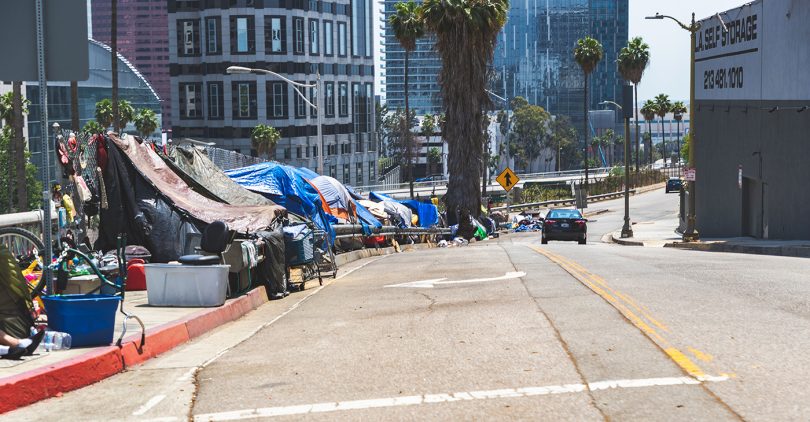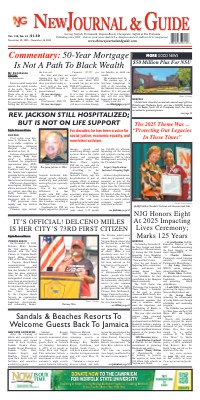National Commentary
“All-In” Plan Would Reduce Homelessness Nationally

By Stacy M. Brown
NNPA Newswire Senior National Correspondent
@StacyBrownMedia
In major U.S. cities, officials have either ramped up or dialogued about efforts to reduce homelessness, with New York City Mayor Eric Adams announcing plans to place the unhoused with severe untreated mental illness into hospitals among the strategies employed.
Now, the Biden-Harris administration has decided to roll out a national push to reduce homelessness by 25% in two years.
Titled “All In: The Federal Strategic Plan to Prevent and End Homelessness,” the initiative, announced on Dec. 19, would mandate federal officials to intervene.
Various government agencies would work with states and cities to target unsheltered homelessness. In addition, the administration would expand housing and services and strengthen efforts to prevent people from being unhoused before they turn to the streets.
“Many Americans live each day without safe or stable housing,” Biden stated. “Some are in emergency shelters. Others live on our streets, exposed to the threats of violence, adverse weather, disease, and so many other dangers exacerbated by homelessness.”
The White House called the plan the “most ambitious effort by any administration to prevent people from becoming homeless, address inequities that disproportionately impact underserved communities, including people of color and other marginalized groups, and help cities and states reduce unsheltered homelessness.”
The “All In” plan outlines new strategies to prevent homelessness and increase the housing supply with supportive services to reach that goal.
Administration officials said these strategies build on the proven “Housing First” model – an approach where housing is the first step to a better, safer, and healthier life and serves as a platform for providing services so people can stay housed.
“All In” also sets the foundation for new initiatives, including one to reduce unsheltered homelessness in a cohort of geographically diverse communities.
Biden called on state and local governments to set goals for 2025 and use “All In” as a blueprint to address homelessness in their communities.
“My plan offers a roadmap for not only getting people into housing but also ensuring that they have access to the support, services, and income that allow them to thrive,” Biden asserted.
“It is a plan that is grounded in the best evidence and aims to improve equity and strengthen collaboration at all levels.”
According to HUD data, 582,462 people were experiencing homelessness on a single night in January 2022 – a slight .3% increase since 2020.
The unsheltered homeless population, including encampments, has increased by more than 3% since 2020. In addition, chronic homelessness, including those with disabilities, increased by 15%.
In New York,65,633 lived in shelters in October 2022, compared with 57,341 in October 2020, according to the Coalition for the Homeless.
The Los Angeles region, which recently counted 69,144 people experiencing homelessness, has realized recent increases, including a 25% jump from 2018 to 2020.
Homelessness has reportedly decreased by 47% in the District of Columbia since 2016.
Because the Biden-Harris administration kept the national eviction moratorium in place until August 2021 and with support from the American Rescue Plan, evictions were prevented, and many vulnerable families could stay in their homes, officials insisted.
The Emergency Rental Assistance program from the American Rescue Plan delivered over 8 million payments to provide rental or utility assistance to individuals at risk for eviction or housing instability.
And the expanded Child Tax Credit helped drive child poverty to record lows in 2021. As a result, eviction filings remained more than 20 percent below historic averages in the 12 months following the expiration of the national eviction moratorium.
Despite overall homelessness remaining relatively flat, the administration noted that the number of people experiencing unsheltered homelessness—including people living in cars and tents – rose by 3%.
“Ending unsheltered homelessness will require a coordinated effort to promote healthy and safe communities where all can live in dignity,” administration officials wrote in a fact sheet.


 Politics1 week ago
Politics1 week agoDigital Download: Closing the Emerging Markets Digital Fair Share Gap

 Hampton Roads Community News1 week ago
Hampton Roads Community News1 week agoBlack Men Rock At Awards Ball

 Black Arts and Culture7 days ago
Black Arts and Culture7 days agoKwanzaa & Emancipation: Dr. Colita N. Fairfax To Speak Jan. 1 On Cultural & Historical Legacy

 Black History1 week ago
Black History1 week agoA Great Generation

 Black History1 week ago
Black History1 week ago’Tis The Season’ The Kwanzaa Holiday Celebrates Heritage, Hope & Community

 Education1 week ago
Education1 week agoBlack VT Students Lament School’s Ending Ujima Program

 National News6 days ago
National News6 days agoHoliday Alert: ’Tis The Season’ For Scammers

 Book Reviews5 days ago
Book Reviews5 days agoBookworm Review: Bloom How You Must: A Black Woman’s Guide To Self-Care & Generational Healing



















